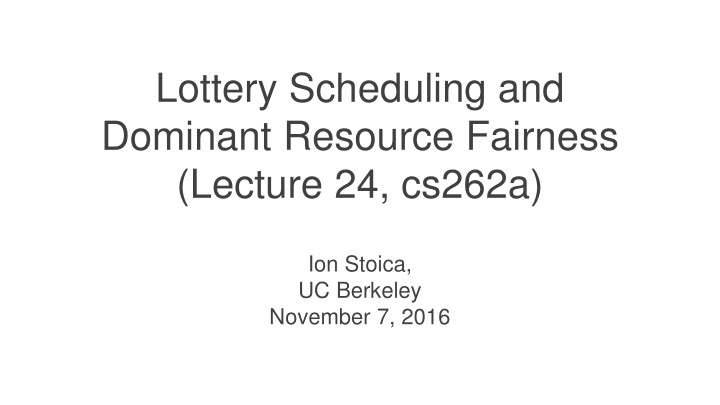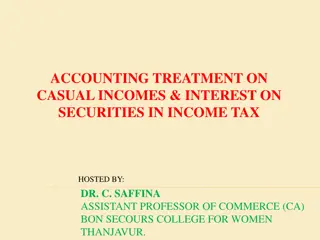
Resource Management Strategies for Efficient Process Scheduling
Learn about lottery scheduling, dominant resource fairness, and the key criteria for an effective scheduler. Explore the concepts of fair sharing, max-min fairness, and widely used strategies in operating systems, networking, and data centers.
Uploaded on | 0 Views
Download Presentation

Please find below an Image/Link to download the presentation.
The content on the website is provided AS IS for your information and personal use only. It may not be sold, licensed, or shared on other websites without obtaining consent from the author. If you encounter any issues during the download, it is possible that the publisher has removed the file from their server.
You are allowed to download the files provided on this website for personal or commercial use, subject to the condition that they are used lawfully. All files are the property of their respective owners.
The content on the website is provided AS IS for your information and personal use only. It may not be sold, licensed, or shared on other websites without obtaining consent from the author.
E N D
Presentation Transcript
Lottery Scheduling and Dominant Resource Fairness (Lecture 24, cs262a) Ion Stoica, UC Berkeley November 7, 2016
Todays Papers Lottery Scheduling: Flexible Proportional-Share Resource Management, Carl Waldspurger and William Weihl, OSDI 94 (www.usenix.org/publications/library/proceedings/osdi/full_papers/waldspurger.pdf) Dominant Resource Fairness: Fair Allocation of Multiple Resource Types Ali Ghodsi, Matei Zaharia, Benjamin Hindman, Andy Konwinski, Scott Shenker, Ion Stoica, NSDI 11 (https://www.cs.berkeley.edu/~alig/papers/drf.pdf)
What do we want from a scheduler? Isolation: have some sort of guarantee that misbehaved processes cannot affect me too much Efficient resource usage: resource is not idle while there is a process whose demand is not fully satisfied Flexibility: can express some sort of priorities, e.g., strict or time based
Single Resource: Fair Sharing CPU 100% 33% n users want to share a resource (e.g. CPU) Solution: give each 1/n of the shared resource 33% 50% 33% 0% 100% Generalized by max Handles if a user wants less than its fair share E.g. user 1 wants no more than 20% max- -min min fairness fairness 20% 40% 50% 40% 0% 100% Generalized by weighted Give weights to users according to importance User 1 gets weight 1, user 2 weight 2 weighted max max- -min min fairness fairness 33% 50% 66% 0%
Why Max-Min Fairness? Weighted Weighted Fair User 1 gets weight 2, user 2 weight 1 Priorities Priorities Give user 1 weight 1000, user 2 weight 1 Revervations Revervations Ensure user 1 gets 10% of a resource Give user 1 weight 10, sum weights 100 Deadline Deadline- -based based scheduling scheduling Given a user job s demand and deadline, compute user s reservation/weight Isolation Isolation Users cannot affect others beyond their share Fair Sharing Sharing / / Proportional Proportional Shares Shares
Widely Used OS: OS: proportional sharing, lottery, Linux s cfs, Networking: Networking: wfq, wf2q, sfq, drr, csfq, ... Datacenters: Datacenters: Hadoop s fair sched, capacity sched, Quincy
Fair Queueing: Max-min Fairness implementation originated in Fair queueing explained in a fluid flow system: reduces to bit- by-bit round robin among flows Each flow receives min(ri, f) , where ri flow arrival rate f link fair rate (see next slide) Weighted Fair Queueing (WFQ) associate a weight with each flow [Demers, Keshav & Shenker 89] In a fluid flow system it reduces to bit-by-bit round robin WFQ in a fluid flow system Generalized Processor Sharing (GPS) [Parekh & Gallager 92]
Fair Rate Computation If link congested, compute f such that i , f)=C min(ri f = 4: min(8, 4) = 4 min(6, 4) = 4 min(2, 4) = 2 10 8 6 2 4 4 2
Fair Rate Computation Associate a weight wiwith each flow i If link congested, compute f such that i 8 6 2 (w3 = 1) , f wi)=C min(ri f = 2: min(8, 2*3) = 6 min(6, 2*1) = 2 min(2, 2*1) = 2 10 (w1 = 3) (w2 = 1) 4 4 2
Fluid Flow System Flows can be served one bit at a time Fluid flow system, also known as Generalized Processor Sharing (GPS) [Parekh and Gallager 93] WFQ can be implemented using bit-by-bit weighted round robin in GPS model During each round from each flow that has data to send, send a number of bits equal to the flow s weight
Generalized Processor Sharing Example link Red session has packets backlogged between time 0 and 10 Other sessions have packets continuously backlogged flows 5 1 1 1 1 1 0 2 4 6 8 10 15
Packet Approximation of Fluid System Standard techniques of approximating fluid GPS Select packet that finishes first in GPS assuming that there are no future arrivals Implementation based on virtual time Assign virtual finish time to each packet upon arrival Packets served in increasing order of virtual times
Approximating GPS with WFQ Fluid GPS system service order 0 Weighted Fair Queueing select the first packet that finishes in GPS 2 4 6 8 10
Implementation Challenge Need to compute the finish time of a packet in the fluid flow system but the finish time may change as new packets arrive! Need to update the finish times of all packets that are in service in the fluid flow system when a new packet arrives But this is very expensive; a high speed router may need to handle hundred of thousands of flows!
Example: Each flow has weight 1 Flow 1 time Flow 2 time Flow 3 time Flow 4 time Finish times computed at time 0 time 0 1 2 3 Finish times re-computed at time time 0 1 2 3 4
Solution: Virtual Time Key Observation: while the finish times of packets may change when a new packet arrives, the order in which packets finish doesn t! Only the order is important for scheduling Solution: instead of the packet finish time maintain the number of rounds needed to send the remaining bits of the packet (virtual finishing time) Virtual finishing time doesn t change when the packet arrives System virtual time index of the round in the bit-by-bit round robin scheme
System Virtual Time: V(t) Measure service, instead of time V(t) slope normalized rate at which every backlogged flow receives service in the fluid flow system C link capacity N(t) total weight of backlogged flows in fluid flow system at time t V(t) ( t ) V t C = ( ) N t time
System Virtual Time (V(t)): Example V(t) increases inversely proportionally to the sum of the weights of the backlogged flows Packet arrival: height proportional to packet size Flow 1 (w1 = 1) time Flow 2 (w2 = 1) time 3 4 5 1 2 6 1 2 3 4 5 V(t) C/2 C
Fair Queueing Implementation Define k - virtual finishing time of packet k of flow i - arrival time of packet k of flow i - length of packet k of flow i wi weight of flow i The finishing time of packet k+1 of flow i is i F k i a Round when last packet of flow i finishes k i L Current round # of rounds it takes to serve new packet k+1=max(V(ai k+1),Fi k+1/wi k)+Li Fi Round by which each packet is served
Lottery Scheduling An approximation of weighted fair sharing Weight number of tickets Scheduling decision probabilistic: give a slot to a process proportionally to its weight
Fairness analysis (I) Lottery scheduling is probabilistically fair If a thread has a t t tickets out of T T Its probability of winning a lottery is p = t/T Its expected number of wins over n drawings is np Binomial distribution Variance 2 = np(1 p) probabilistically fair
Fairness analysis (II) Coefficient of variation of number of wins /np = ((1-p)/np) Decreases with n Number of tries before winning the lottery follows a geometric distribution distribution geometric As time passes, each thread ends receiving its share of the resource
Introduces a bunch of abstractions and mechanisms Ticket transfers Ticket currencies Compensation tickets Applied to other resources, e.g., memory
Ticket transfers Explicit transfers of tickets from one client to another They an be used whenever a client blocks due to some dependency When a client waits for a reply from a server, it can temporarily transfer its tickets to the server They eliminate priority inversions priority inversions
Ticket inflation Lets users create new tickets Like printing their own money Counterpart is ticket deflation ticket deflation Normally disallowed Normally disallowed except among mutually trusting clients Lets them to adjust their priorities dynamically without explicit communication
Ticket currencies (I) Consider the case of a user managing multiple threads Want to let her favor some threads over others Without impacting the threads of other users
Ticket currencies (II) Will let her create new tickets but will debase the individual values of all the tickets she owns Her tickets will be expressed in a new currency exchange rate exchange rate with the base currency base currency currency that will have a variable
Example (I) Ann manages three threads A has 5 tickets B has 3 tickets C has 2 tickets Ann creates 5 extra tickets and assigns them to process C Ann now has 15 tickets
Example (II) These 15 tickets represent 15 units of a new currency whose exchange rate with the base currency is 10/15 The total value of Ann tickets expressed in the base currency is still equal to 10
Compensation tickets (I) I/O-bound threads are likely get less than their fair share of the CPU because they often block before their CPU quantum expires Compensation tickets address this imbalance
Compensation tickets (II) A client that consumes only a fraction f of its CPU quantum can be granted a compensation ticket compensation ticket Ticket inflates the value of all client tickets by 1/f until the client starts gets the CPU (Wording in the paper is much more abstract) can
Example CPU quantum is 100 ms Client A releases the CPU after 20ms f f = 0.2 or 1/5 = 0.2 or 1/5 Value of all all tickets owned by A will be multiplied by 5 until A gets the CPU
Compensation tickets (III) Compensation tickets Favor I/O-bound and interactive threads Helps them getting their fair share of the CPU
Summary (I) Weighted max-min fairness a very useful abstraction with strong properties Provides isolation (sharing guarantee) Strategy proof (cannot be gained) Efficient resource usage (if someone doesn t use resource someone else can use it) Can emulate lots of scheduling policies
Summary (I|) Lottery scheduling An approximation of Weighted Fair Queueing in processor domain Introduces a bunch of useful abstractions
Thoerethical Properties of Max-Min Fairness Share guarantee Each user gets at least 1/n of the resource But will get less if her demand is less Strategy-proof Users are not better off by asking for more than they need Users have no reason to lie
Why is Max-Min Fairness Not Enough? Job scheduling is not only about a single Tasks consume CPU, memory, network and disk I/O single resource What are task demands today?
Heterogeneous Resource Demands Some Some tasks CPU CPU- -intensive intensive tasks are are Some tasks are Some tasks are memory memory- -intensive Most task Most task need <2 CPU, 2 GB RAM> <2 CPU, 2 GB RAM> need ~ ~ intensive 2000 2000- -node Hadoop Cluster at Facebook (Oct 2010) node Hadoop Cluster at Facebook (Oct 2010) 39
Problem 100% 100% 2 resources: CPUs & mem User 1 wants <1 CPU, 4 GB> <1 CPU, 4 GB> per task User 2 wants <3 CPU, 1 GB> <3 CPU, 1 GB> per task What s What s a fair a fair allocation allocation? ? ? ? ? ? 50% 50% 0% 0% CPU CPU mem mem
A Natural Policy Asset Fairness Equalize each user s sum sum of of resource resource shares shares Cluster with 28 CPUs, 56 GB RAM U1 needs <1 CPU, 2 GB RAM> per task, or <3.6% CPUs, 3.6% RAM> per task U2 needs <1 CPU, 4 GB RAM> per task, or <3.6% CPUs, 7.2% RAM> per task Better off in a separate cluster with half the resources 100% 100% 43% 43% 43% 43% Problem: violates share guarantee User 1 has < 50% of both CPUs and RAM 50% 50% 57 57% % 28% 28% 0% 0% CPU CPU RAM RAM Asset fairness yields U1: 12 tasks: <43% CPUs, 43% RAM> ( =86%) U2: 8 tasks: <28% CPUs, 57% RAM> ( =86%) User 1 User 1 User 2 User 2
Cheating the Scheduler Users willing to game the system to get more resources Real-life examples A cloud provider had quotas on map and reduce slots Some users found out that the map-quota was low. Users Users implemented maps in the reduce slots! implemented maps in the reduce slots! A search company provided dedicated machines to users that could ensure certain level of utilization (e.g. 80%). Users Users used busy used busy- -loops to inflate utilization loops to inflate utilization
Challenge Can we find a fair sharing policy that provides Share guarantee Strategy-proofness Can we generalize max-min fairness to multiple resources?
Dominant Resource Fairness (DRF) A user s dominant resource is the resource user has the biggest share of Example: Total resources: User 1 s allocation: 8 CPU 2 CPU 5 GB 1 GB 20% RAM 25% CPUs Dominant resource of User 1 is CPU (as 25% > 20%) A user s dominant share: fraction of dominant resource she is allocated User 1 s dominant share is 25% 25%
Dominant Resource Fairness (DRF) Apply Apply max max- -min min fairness fairness to to dominant dominant shares shares Equalize the dominant share of the users. Example: Total resources: < <9 CPU, 18 GB 9 CPU, 18 GB> > User 1 demand: <1 CPU, 4 GB>; <1 CPU, 4 GB>; dom res: mem User 2 demand: <3 CPU, 1 GB>; <3 CPU, 1 GB>; dom res: CPU mem (1/9 < 4/18) CPU (3/9 > 1/18) 100% 100% User 1 User 1 User 2 User 2 12 GB 12 GB 66% 66% 3 CPUs 3 CPUs 50% 50% 66% 66% 6 CPUs 6 CPUs 2 GB 2 GB 0% 0% CPU CPU (9 total) (9 total) mem mem (18 total) (18 total)
Online DRF Scheduler Whenever there are available resources and tasks to run: Schedule a task to the user with smallest dominant share
Why not use pricing? Approach Set prices for each good Let users buy what they want Problem How do we determine the right prices for different goods?
How would an economist solve it? Let the market determine the prices Competitive Equilibrium from Equal Incomes (CEEI) Give each user 1/n of every resource Let users trade in a perfectly competitive market Not strategy Not strategy- -proof! proof!
Properties of Policies Property Share guarantee Strategy-proofness Pareto efficiency Envy-freeness Single resource fairness Bottleneck res. fairness Population monotonicity Resource monotonicity Asset CEEI DRF Conjecture: Assuming non-zero demands, DRF is the only allocation that is strategy proof and provides sharing incentive (Eric Friedman, Cornell)
Summary Scheduling necessary to deal with oversubscribed resources Need to provide isolation Need high resource efficiency Weighted fair queuing achieves many desirable properties Many mechanisms to implement it (e.g., Lottery scheduling) But limited to a single resource.. Dominant Resource Fairness (DRF): Schedules resources of multiple types while preserving WFQ properties
















